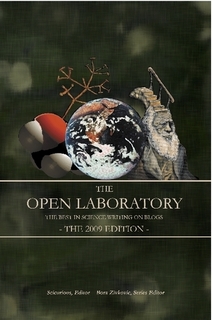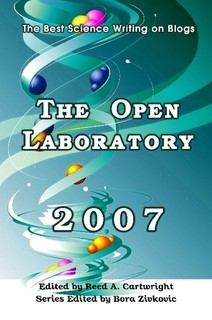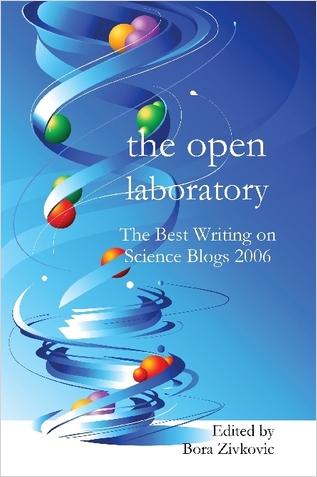There are 19 new articles in PLoS ONE today. As always, you should rate the articles, post notes and comments and send trackbacks when you blog about the papers. You can now also easily place articles on various social services (CiteULike, Mendeley, Connotea, Stumbleupon, Facebook and Digg) with just one click. Here are my own picks for the week - you go and look for your own favourites:
Winter Active Bumblebees (Bombus terrestris) Achieve High Foraging Rates in Urban Britain:
Foraging bumblebees are normally associated with spring and summer in northern Europe. However, there have been sightings of the bumblebee Bombus terrestris during the warmer winters in recent years in southern England. But what floral resources are they relying upon during winter and how much winter forage can they collect? To test if urban areas in the UK provide a rich foraging niche for bees we set up colonies of B. terrestris in the field during two late winter periods (2005/6 & 2006/7) in London, UK, and measured their foraging performance. Fully automatic radio-frequency identification (RFID) technology was used in 2006/7 to enable us to record the complete foraging activity of individually tagged bees. The number of bumblebees present during winter (October 2007 to March 2008) and the main plants they visited were also recorded during transect walks. Queens and workers were observed throughout the winter, suggesting a second generation of bee colonies active during the winter months. Mass flowering shrubs such as Mahonia spp. were identified as important food resources. The foraging experiments showed that bees active during the winter can attain nectar and pollen foraging rates that match, and even surpass, those recorded during summer. B. terrestris in the UK are now able to utilise a rich winter foraging resource in urban parks and gardens that might at present still be under-exploited, opening up the possibility of further changes in pollinator phenology.
The mosquito Wyeomyia smithii overwinters in a larval diapause that is initiated, maintained and terminated by day length (photoperiod). We use a forward genetic approach to investigate transcriptional events involved in the termination of diapause following exposure to long-days. We incorporate a novel approach that compares two populations that differentially respond to a single day length. We identify 30 transcripts associated with differential response to day length. Most genes with a previously annotated function are consistent with their playing a role in the termination of diapause, in downstream developmental events, or in the transition from potentially oxygen-poor to oxygen-rich environments. One gene emerges from three separate forward genetic screens as a leading candidate for a gene contributing to the photoperiodic timing mechanism itself (photoperiodic switch). We name this gene photoperiodic response gene 1 (ppdrg1). WsPpdrg1 is up-regulated under long-day response conditions, is located under a QTL for critical photoperiod and is associated with critical photoperiod after 25 generations of recombination from a cross between extreme phenotypes. Three independent forward genetic approaches identify WsPpdrg1 as a gene either involved in the photoperiodic switch mechanism or very tightly linked to a gene that is. We conclude that continued forward genetic approaches will be central to understanding not only the molecular basis of photoperiodism and diapause, but also the evolutionary potential of temperate and polar animal populations when confronted with rapid climate change.
Year-Round Tracking of Small Trans-Saharan Migrants Using Light-Level Geolocators:
Since 1899 ringing (or banding) remained the most important source of information about migration routes, stopover sites and wintering grounds for birds that are too small to carry satellite-based tracking systems. Despite the large quantity of migrating birds ringed in their breeding areas in Europe, the number of ring recoveries from sub-Saharan Africa is very low and therefore the whereabouts of most small bird species outside the breeding season remain a mystery. With new miniaturized light-level geolocators it is now possible to look beyond the limits of ring recovery data. Here we show for the first time year round tracks of a near passerine trans-Saharan migrant, the European Hoopoe (Upupa epops epops). Three birds wintered in the Sahel zone of Western Africa where they remained stationary for most of the time. One bird chose a south-easterly route following the Italian peninsula. Birds from the same breeding population used different migration routes and wintering sites, suggesting a low level of migratory connectivity between breeding and wintering areas. Our tracking of a near passerine bird, the European Hoopoe, with light-level geolocators opens a new chapter in the research of Palaearctic-African bird migration as this new tool revolutionizes our ability to discover migration routes, stopover sites and wintering grounds of small birds.
Threatened Corals Provide Underexplored Microbial Habitats:
Contemporary in-depth sequencing of environmental samples has provided novel insights into microbial community structures, revealing that their diversity had been previously underestimated. Communities in marine environments are commonly composed of a few dominant taxa and a high number of taxonomically diverse, low-abundance organisms. However, studying the roles and genomic information of these "rare" organisms remains challenging, because little is known about their ecological niches and the environmental conditions to which they respond. Given the current threat to coral reef ecosystems, we investigated the potential of corals to provide highly specialized habitats for bacterial taxa including those that are rarely detected or absent in surrounding reef waters. The analysis of more than 350,000 small subunit ribosomal RNA (16S rRNA) sequence tags and almost 2,000 nearly full-length 16S rRNA gene sequences revealed that rare seawater biosphere members are highly abundant or even dominant in diverse Caribbean corals. Closely related corals (in the same genus/family) harbored similar bacterial communities. At higher taxonomic levels, however, the similarities of these communities did not correlate with the phylogenetic relationships among corals, opening novel questions about the evolutionary stability of coral-microbial associations. Large proportions of OTUs (28.7-49.1%) were unique to the coral species of origin. Analysis of the most dominant ribotypes suggests that many uncovered bacterial taxa exist in coral habitats and await future exploration. Our results indicate that coral species, and by extension other animal hosts, act as specialized habitats of otherwise rare microbes in marine ecosystems. Here, deep sequencing provided insights into coral microbiota at an unparalleled resolution and revealed that corals harbor many bacterial taxa previously not known. Given that two of the coral species investigated are listed as threatened under the U.S. Endangered Species Act, our results add an important microbial diversity-based perspective to the significance of conserving coral reefs.
Attribute Pair-Based Visual Recognition and Memory:
In the human visual system, different attributes of an object, such as shape, color, and motion, are processed separately in different areas of the brain. This raises a fundamental question of how are these attributes integrated to produce a unified perception and a specific response. This "binding problem" is computationally difficult because all attributes are assumed to be bound together to form a single object representation. However, there is no firm evidence to confirm that such representations exist for general objects. Here we propose a paired-attribute model in which cognitive processes are based on multiple representations of paired attributes. In line with the model's prediction, we found that multiattribute stimuli can produce an illusory perception of a multiattribute object arising from erroneous integration of attribute pairs, implying that object recognition is based on parallel perception of paired attributes. Moreover, in a change-detection task, a feature change in a single attribute frequently caused an illusory perception of change in another attribute, suggesting that multiple pairs of attributes are stored in memory. The paired-attribute model can account for some novel illusions and controversial findings on binocular rivalry and short-term memory. Our results suggest that many cognitive processes are performed at the level of paired attributes rather than integrated objects, which greatly facilitates the binding problem and provides simpler solutions for it.












